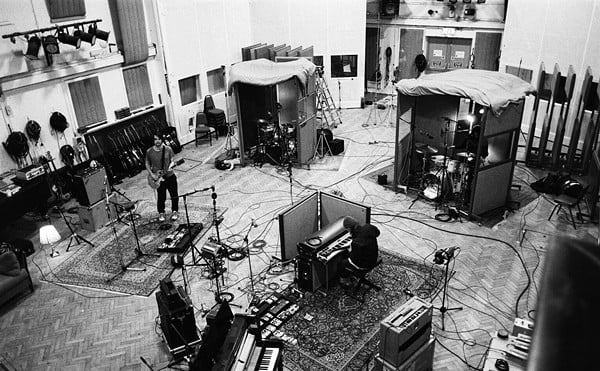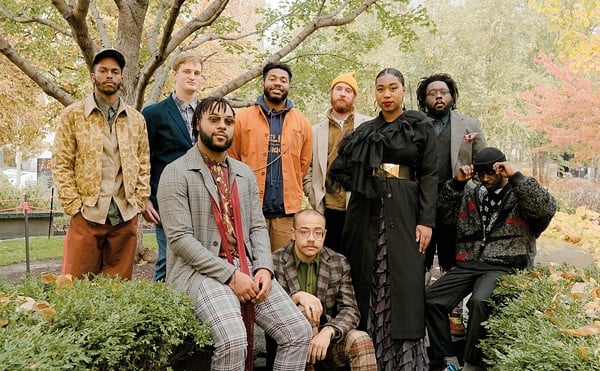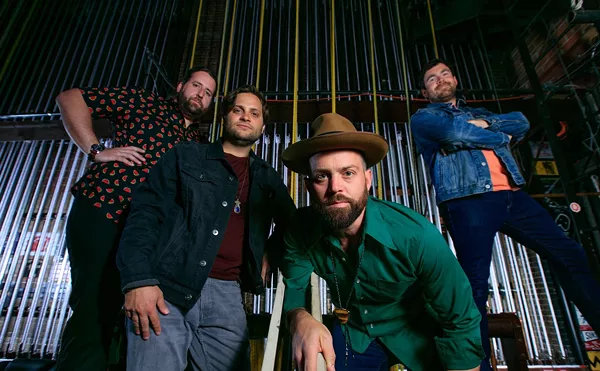Spring 1985. The Feelies are playing a small bar in New Brunswick, New Jersey. I've been in college for about a year, and during that time, I've gotten to know a local band who is near-evangelical about Crazy Rhythms, the Feelies' debut album from several years earlier. I've only heard a few of the Feelies' songs, but I trust the band's judgment enough to sneak my underage self into this show. There aren't many people here, maybe 30, tops; most of my friends are at another show across town. However, it's immediately clear that I've made the right decision. Two drummers, two guitarists, no clear "leader." Very much a rock band, but with a twist: The vocals are buried, the songs fade in and out at will, and there are moments of extended trancelike beauty not at all removed from the Velvet Underground albums I've been checking out at the college radio station.
For their encore, the Feelies play a song that I will later know as "Raised Eyebrows." It begins as a simple instrumental, with short, impossibly quick drum breaks that sound like amplified crickets. Halfway through, there are two clicks, and the mood suddenly changes: the tempo doubles, the singers are into another variation of the "whoa-oh-oh" choruses I've been hearing all night, and everyone's bobbing up and down. I am astonished. I've simply never seen or heard a band like this.
As I'd soon realize, the Feelies were beginning to come out of hibernation. The band would soon hook up with Peter Buck and record its second album. Over the next several years, I will see the Feelies at least two dozen times — often at Maxwell's, their Hoboken home base — and the band will be that great every time. I will start to make Feelies friends, people whom I only see at their shows. When the Feelies themselves are not available, I will go see related bands such as Speed the Plough and Wild Carnation. They are one of my favorite bands of the era and the single best live band I've ever seen.
I share these memories not to rub it in for those of you who weren't there, but to illustrate just how big of a deal this band was for those of us from a certain time and place. Then as now, to be a "bridge and tunnel" person was to be considered uncool, déclassé, by the New York hipsters. New Jersey mostly was considered the land of Springsteen and Bon Jovi. Meanwhile, here was this band of collegiate-looking nerds from Haledon, New Jersey, who melded the Velvet Underground, the Stooges, early Modern Lovers, mid-period Beatles and even Neu! into a controlled, tightly wound ball. To those of us who grew up in the shadow of Manhattan and regularly took the PATH train across the Hudson, the Feelies were instantly relatable — a band clearly aware of what was going on in New York but creating their own version out of necessity.
This week, two unexpected chapters are being added to the Feelies' legacy. First of all, Bar/None Records is reissuing Crazy Rhythms and The Good Earth with copious liner notes, unseen photos and bonus tracks. Secondly, the Feelies will perform Crazy Rhythms in its entirety at the All Tomorrow's Parties festival in upstate New York. If this doesn't sound like a huge deal — another little-known band getting the reissue treatment — consider that, as recently as two years ago, the chances of ever seeing the Feelies' classic lineup seemed about as likely as a Ramones reunion with all original members.
Since the Feelies' breakup in 1991, lead singer/guitarist Glenn Mercer and percussionist Dave Weckerman never stopped working. But as far as any of us knew, guitarist and cowriter Bill Million had absconded to Florida with his family sometime in the early '90s. There he'd taken some sort of locksmith job at Walt Disney World and made a total break from his former bandmates. In 2007, however, Mercer released a solo album that included contributions from all the former Feelies — except Million.
Finally, word leaked out: Million had resurfaced, and the band would reunite to play two shows: one at Maxwell's and one opening for Sonic Youth in Manhattan. Since then they've played another dozen or so shows (so far, no closer to St. Louis than Chicago) whenever everyone has the time or inclination to get together. This has raised interest in the initial two albums, which up until now had fallen in and out of print. You could say the Feelies' time is now, except they've always inhabited their own insular world and have been the better for it.
"I don't talk much because it gets in the way. Don't let it get in the way."
That's from the title track of Crazy Rhythms. It's about as close a statement of intent as this famously reticent band ever made: a vow to avoid those who "talk and don't have much to say," instead choosing to "do a job and get things done/Work real hard and get things done." It hasn't exactly turned out that way — they released only four albums in fifteen years — but it's true that the Feelies have mostly preferred making music to talking much about it.
In preparation for this article, I spent some time on the phone with Mercer. The man isn't given to extended answers, and our conversation was polite but noncommittal. We discussed very little that a quick Google search wouldn't reveal. The closest I got to exclusive information is when he told me how Lydia Lunch considered the Feelies her "little brothers," which must have seemed a little scary at the time.
However, Mercer did clear up one mystery for me: How come the first two albums are so different? Crazy Rhythms is a ball of nervousness, while The Good Earth is pastoral and relaxed in comparison.
"Well, the first one was inspired by our experiences in New York — playing shows at Max's, staying with our manager, Terry Ork," he suggested. "The second one was more inspired by our friends and playing locally."
It's easy to forget that the Feelies were quite the buzz band around NYC. Between 1977 and 1981, it recorded demos with Carla Bley, had one of the legendary scenester managers in Ork, released records on Stiff and Rough Trade, and were toasted by the Village Voice. The band's drummer was Anton Fier, already a well-known name through his work in the Lounge Lizards. Director Susan Seidelman used their music as the soundtrack to Smithereens. Jonathan Demme not only cast them in Something Wild, but proposed creating a feature film around them — a film that, according to legend, ended up being Talking Heads' Stop Making Sense. All this for a band that once said they didn't like playing New York shows because "we get real bad headaches going through the tunnel."
With its nerd-chic cover art, mutant Bo Diddley beat and song titles like "Moscow Nights" and "The Boy with the Perpetual Nervousness," Crazy Rhythms definitely fit in with the 1980 idea of "new wave." Where the Feelies differed from its Stiff Records labelmates was in its perfectionist tendencies — apparently the band infuriated producer Mark Abel with its refusal to let him actually produce — and the extended, trancelike moods of the best songs. It's hard to imagine Stiff peers such as Nick Lowe and Wreckless Eric having the patience for, say, "Forces at Work," which gathers its strength like an oncoming thunderstorm for several minutes.
It wasn't surprising that the Feelies left Stiff soon afterward — the label didn't like the band's new direction, and the band was turned off by the label's brash promotion techniques and package tours. Then the rhythm section quit, and the remaining Feelies took their first hiatus. However, Million, Mercer and Weckerman were hardly sitting around at home.
In fact, the band was probably busier between 1982 and 1985 than it ever would be again. The Feelies hooked up with bassist Brenda Sauter and drummer Stan Demeski in a series of small bands. There was Yung Wu, which featured percussionist Dave Weckerman on lead vocals; the Trypes, a septet that released one stunning EP of semi-psychedelic pop; the Willies, mostly a cover band, and (for one show) Dr. Robert, an all-Beatles cover band. At some point the Willies turned back into the Feelies, Buck entered the picture, and The Good Earth came out in 1986.
Where Crazy Rhythms was rubber-band tight, The Good Earth was a direct descendant of the Trypes/Willies era: subtler, more textured and approachable. Which isn't to say the Feelies abandoned its trademark approach — "The Last Roundup" and "Two Rooms" are almost heart-stopping, and "Slipping (Into Something)" begins as a third-album Velvet Underground pastiche and ends in a maelstrom of guitar noise and speedy tempos. But there's also the title track and "Let's Go," which follow a more conventional verse/chorus structure, and the mantralike "When Company Comes" and "Slow Down." The Good Earth could have come out anytime between 1972 and last week, and it would have sounded every bit as current.
This Feelies lineup lasted for two more albums and into the early '90s. Since then, Mercer has never really stopped working — besides his solo projects, he played with Weckerman in Wake Ooloo and with several ex-Trypes in the Sunburst. Currently, the Feelies are once again taking up most of his time; the band's even played new songs in concert. When asked about future plans, however, Mercer remains characteristically vague. "Bill still lives in Florida, and everyone has kids or family commitments," he says. "It's hard to get everyone together at the same time."





